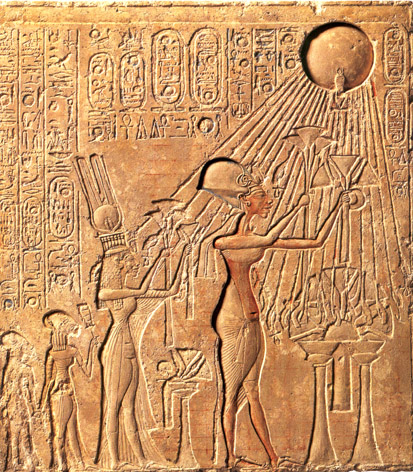
Akhenaten refresher
- Egyptian Pharaoh who ruled for 17 years in middle of fourteenth century, up till around 1336 or 1334 BCE
- originally known as Amenthotep IV (or in Greek, Amenophis IV); changed his name to Akhenaten
- opposed the orthodox priests of Ammon-Re; redirected their income to his new god Aton
- abolished traditional cults and idols of Egyptian polytheism
- established the sole worship of a new god of light, Aton, (variously described as monotheism, monolatrism and henotheism)
- depicted Aton as sun disc with rays ending in hands, understood to be a universal god incapable of true representation
- established new centre of worship at Akhetaten (today known as Amarna)
- temples to Aten stressed worship in open sunlight (contrary to earlier custom of darkened indoor temples)
- Akhenaten was the sole mediator between Aton and earth
- affinities between Hymn to Aton and Psalm 104
- son was the famous Tutankhamen
Unlike Moses, Akhenaten, Pharaoh Amenophis IV, was a figure exclusively of history and not of memory. Shortly after his death, his name was erased from the king-lists, his monuments were dismantled, his inscriptions and representations were destroyed, and almost every trace of his existence was obliterated. For centuries no one knew of his extraordinary revolution. Until his rediscovery in the nineteenth century, there was virtually no memory of Akhenaten.
Moses represents the reverse case. No traces have ever been found of his historical existence. He grew and developed only as a figure of memory, absorbing and embodying all traditions that pertained to legislation, liberation, and monotheism. (Assmann, Moses the Egyptian, p. 23)
This current series of posts has arisen out of Professor Chris Keith’s references to Egyptologist Jan Assmann’s comments about social memory theory in history. Keith uses memory theory to “answer questions about the historical Jesus”. By starting with the gospel narratives as memories of Jesus that have been necessarily reinterpreted he attempts to uncover those narrative details that most likely point to a past reality about Jesus. In Jesus’ Literacy, for example, he judges the Gospel of Mark’s implication that Jesus was was not scribally literate to be more likely a memory reflection of the real historical Jesus than the Gospel of Luke’s suggestion that Jesus was able to competently read the Jewish Scriptures.
However, when I read the first two chapters of Assmann’s Moses the Egyptian I read an approach to social memory that is the opposite of the one used by Chris Keith. Keith begins with the Gospels that are assumed to record certain memory-impressions and attempts to work backwards to what those original events more or less looked like to observers. But as I wrote in my earlier post that’s not how the Egyptologist works:
The Egyptologist begins with “hard evidence” and originally genuine historical memories and works his way forward into the later literature to find out what must have become of these memories. The historical Jesus scholar, it appears to me, begins with the later literature and tries to guess what memories came before it.
The two methods look to me to be like polar opposites rather than “similar”.
It is a pity Chris Keith is too busy to engage with Vridar (no reason given in his personal email, just a copy of a cordial invitation to respond to a Nigerian banker-benefactor asking me for my account details) at the cost of public religious literacy. I would love to discuss these questions with him seriously but he’s clearly not interested. (Slightly revised)
The difference is potentially very significant. Take the different versions of the Moses-Exodus narratives that we have seen in the recent posts — each one a differently interpreted memory — and apply Keith’s method to those in order to arrive at information about “the historical Moses” and the “historical Exodus” and see what happens. As we saw in that first post Assmann has doubts that there even was a historical Moses in the first place and he does not believe there ever was a biblical-like Exodus led by such a figure. Applying Keith’s method to “answer questions about the historical Jesus” to these memory-narratives would produce a very false notion of Egyptian and Jewish history.
Assmann starts with something we lack in the case of the historical Jesus. The known events of Egyptian history according to the contemporary inscriptions. These are used to interpret the later “memory literature”. The “memory literature” is not used in an attempt to uncover past historical events. The past historical events are used to interpret the subsequent stories.
Keith may object that he does use what is known of the historical past in order to assess what is closest to historical reality in the Gospels. He does, for example, in Jesus’ Literacy delve into what we can know about the nature and extent of literacy in ancient Palestine. But this tells us nothing new or relevant to the actual historical Jesus. It is comparable to uncovering details about the historical Pilate, or the architecture of the Jerusalem Temple, or the geography of Galilee. No-one would believe we are coming any closer to “the historical Moses” by learning all we can about the Egyptian religious customs and beliefs, the social structures, ethnic groups or literacy in ancient Egypt and Palestine and applying this knowledge to any of the stories we have about Moses.
So here’s how Assmann uses social memory. Continue reading “Tales of Jesus and Moses: Two Ways to Apply Social Memory in Historical Studies”
